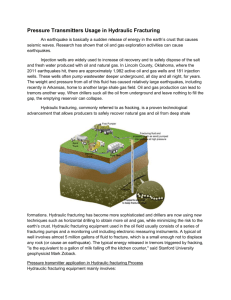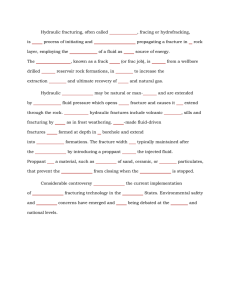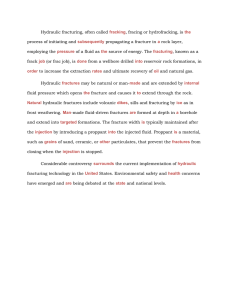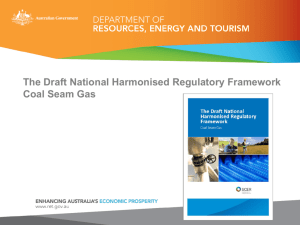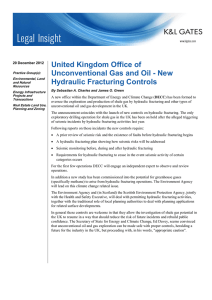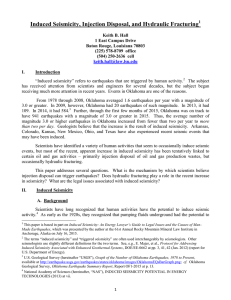Does Hydraulic Fracturing Cause Earthquakes? Facts on Geo
advertisement
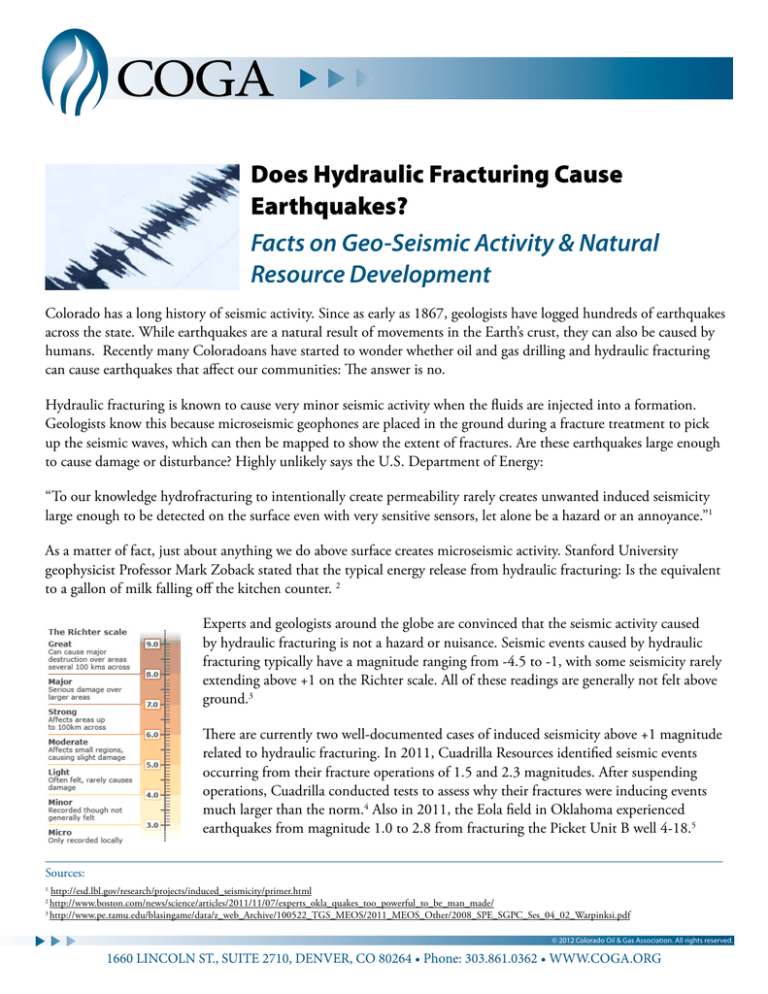
Does Hydraulic Fracturing Cause Earthquakes? Facts on Geo-Seismic Activity & Natural Resource Development Colorado has a long history of seismic activity. Since as early as 1867, geologists have logged hundreds of earthquakes across the state. While earthquakes are a natural result of movements in the Earth’s crust, they can also be caused by humans. Recently many Coloradoans have started to wonder whether oil and gas drilling and hydraulic fracturing can cause earthquakes that affect our communities: The answer is no. Hydraulic fracturing is known to cause very minor seismic activity when the fluids are injected into a formation. Geologists know this because microseismic geophones are placed in the ground during a fracture treatment to pick up the seismic waves, which can then be mapped to show the extent of fractures. Are these earthquakes large enough to cause damage or disturbance? Highly unlikely says the U.S. Department of Energy: “To our knowledge hydrofracturing to intentionally create permeability rarely creates unwanted induced seismicity large enough to be detected on the surface even with very sensitive sensors, let alone be a hazard or an annoyance.”1 As a matter of fact, just about anything we do above surface creates microseismic activity. Stanford University geophysicist Professor Mark Zoback stated that the typical energy release from hydraulic fracturing: Is the equivalent to a gallon of milk falling off the kitchen counter. 2 Experts and geologists around the globe are convinced that the seismic activity caused by hydraulic fracturing is not a hazard or nuisance. Seismic events caused by hydraulic fracturing typically have a magnitude ranging from -4.5 to -1, with some seismicity rarely extending above +1 on the Richter scale. All of these readings are generally not felt above ground.3 There are currently two well-documented cases of induced seismicity above +1 magnitude related to hydraulic fracturing. In 2011, Cuadrilla Resources identified seismic events occurring from their fracture operations of 1.5 and 2.3 magnitudes. After suspending operations, Cuadrilla conducted tests to assess why their fractures were inducing events much larger than the norm.4 Also in 2011, the Eola field in Oklahoma experienced earthquakes from magnitude 1.0 to 2.8 from fracturing the Picket Unit B well 4-18.5 Sources: http://esd.lbl.gov/research/projects/induced_seismicity/primer.html http://www.boston.com/news/science/articles/2011/11/07/experts_okla_quakes_too_powerful_to_be_man_made/ 3 http://www.pe.tamu.edu/blasingame/data/z_web_Archive/100522_TGS_MEOS/2011_MEOS_Other/2008_SPE_SGPC_Ses_04_02_Warpinksi.pdf 1 2 © 2012 Colorado Oil & Gas Association. All rights reserved. 1660 LINCOLN ST., SUITE 2710, DENVER, CO 80264 • Phone: 303.861.0362 • WWW.COGA.ORG In both cases, fracture stimulations were affecting existing fault lines, which amplified the tremors. However, the magnitudes of these events were not large enough to cause damage to structures. Considering that there have been over 1,000,000 fracture stimulations in the United States alone, the amount of well-known seismic events above +1.0 is extremely small. Recent speculation about hydraulic fracturing and earthquakes has been raised because of events in Ohio and Arkansas. But reports of these events confused hydraulic fracturing with disposal wells. Underground injection control (UIC) wells pump liquids from many industrial processes deep into the ground, typically into a formation that can support the absorption of trillions of gallons. Waste injection wells are nothing new; they have been around since the 1930s and there are more than 500,000 across the country. The Environmental Protection Agency (EPA) regulates this disposal method.6 Underground waste injection is not solely used by the oil and gas industry. Municipalities, chemical companies, and other industries use these wells to dispose of hazardous liquids, stormwater, or other unwanted liquid waste. Since the 1930s, the EPA has gone through multiple reviews that increase safety around these wells, including methods and practices to ensure safety of groundwater by ensuring the injected waste stays in the target formation.7 In states such as Ohio and Arkansas, these waste wells are speculated to activate existing natural faults, which can in turn cause seismic activity. It makes sense that injection of fluids over periods of weeks and months could build up pressure in existing faults, causing earthquake activity. Tremors from the two events in Ohio and Arkansasa did not exceed 4.7, causing minor damage to buildings.8 While geologists and geophysicists are studying a possible connection between underground injection waste wells, data indicate that earthquake activity stops when injection ceases, limiting concerns for future earthquakes. In Colorado, there are 575 underground injection control waste disposal wells, 355 of these are active.9 To see a map of known earthquake activity and corresponding faults in Colorado, please click here. In summary, while hydraulic fracturing is known to cause very small seismic activity beneath the ground surface, this activity cannot be detected at the surface. Of one-half million disposal wells across the country, two have been associated with minor seismic activity. In Colorado, we know that oil and gas development activity can be conducted safely, without fear of earthquakes. Sources: http://www.cuadrillaresources.com/cms/wp-content/uploads/2011/12/Geosphere-Final-report-rev-1.pdf http://www.ogs.ou.edu/pubsscanned/openfile/OF1_2011.pdf 6 http://water.epa.gov/type/groundwater/uic/ 7 http://water.epa.gov/type/groundwater/uic/history.cfm 8 http://www.foxnews.com/scitech/2011/03/01/fracking-earthquakes-arkansas-man-experts-warn/ 9 COGCC 4 5 Note to Readers: COGA welcomes feedback and corrections on our fact sheets. Please email Travis@coga.org. © 2012 Colorado Oil & Gas Association. All rights reserved. 1660 LINCOLN ST., SUITE 2710, DENVER, CO 80264 • Phone: 303.861.0362 • WWW.COGA.ORG
